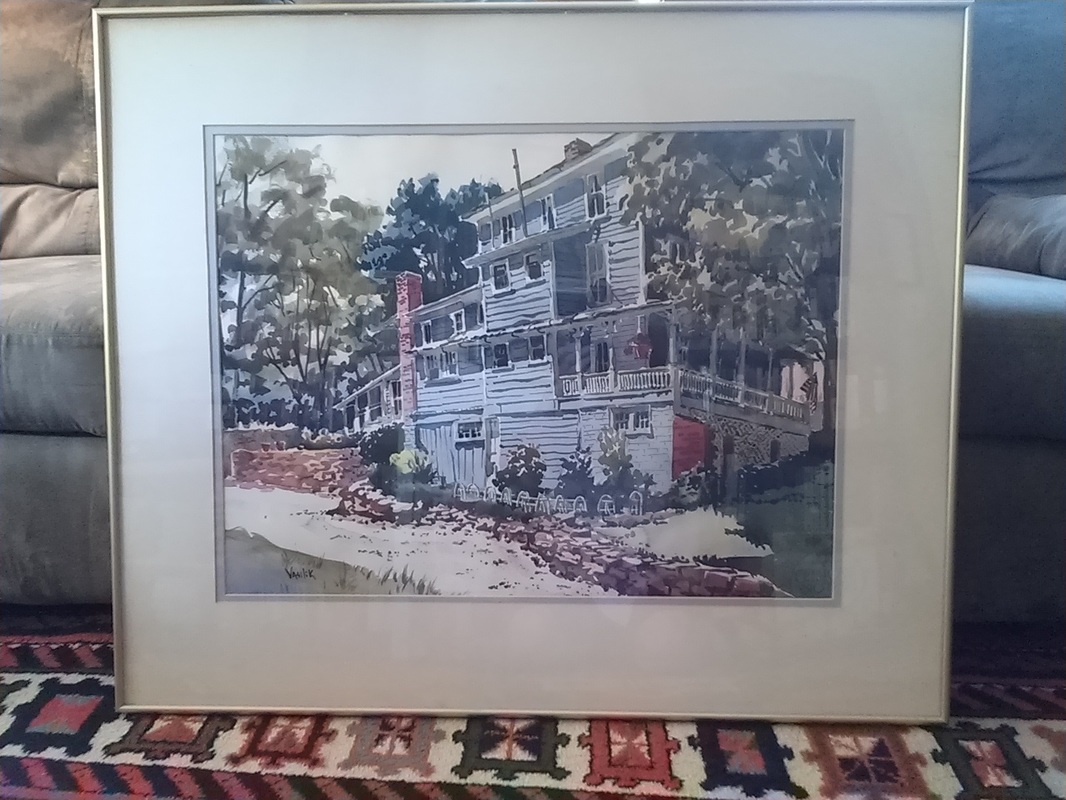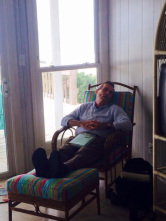During the twenty years we operated our bed-and-breakfast, several people photographed, sketched, or painted the Palmer House. Nearly all of them chose to stand on the other side of Pigeon Street to capture a frontal view of the house.
Not so Anne Vasilik. She walked down the hill and put onto her canvas the house as seen from the driveway side of the property. This approach more truthfully captures the essence, form, and spirit of the old tourist home than all the others. Here are the bathrooms, tacked like thick buttresses to the original structure. Jutting out from these roofs are the stack pipes and rickety chimneys. The irregular lines of the Palmer House; the rambling construction resulting from so many add-ons and slipshod work over the years; the changes wrought by Kris and me: all of these Vasilik captures in her watercolor.
Not so Anne Vasilik. She walked down the hill and put onto her canvas the house as seen from the driveway side of the property. This approach more truthfully captures the essence, form, and spirit of the old tourist home than all the others. Here are the bathrooms, tacked like thick buttresses to the original structure. Jutting out from these roofs are the stack pipes and rickety chimneys. The irregular lines of the Palmer House; the rambling construction resulting from so many add-ons and slipshod work over the years; the changes wrought by Kris and me: all of these Vasilik captures in her watercolor.
When I hit age thirty, I felt a growing desire in me to own a home. For nearly two years, in a lazy, off-and-on way, Kris and I looked for such a home in places as diverse as Charlottesville, Virginia, and Avon, North Carolina, a town on the Outer Banks. On a family vacation in the Smoky Mountains in the summer of 1982—none of my siblings as yet had children, and we gathered once a year in the mountains or at the beach—we stumbled across a decrepit, abandoned tourist home in Waynesville. Weirdly enough, my stepfather, my mother’s husband who was with us on the vacation, had rented a room in the Palmer House some thirty years earlier while for the local radio station.
Most potential buyers were undoubtedly appalled by the condition of the Palmer House. The white paint on the outside walls was chipped and peeling, and in several areas was stained orange by nearby metal pipes and gutters. Tendrils of Virginia creeper had snaked their way up these walls to the third floor windows. Some of the roofs leaked, and the realtor had no idea whether the chimneys worked well enough to release smoke from the oil furnace. The dining room floor had rotted; a couple of the floors in the bedrooms had buckled with age; half of the front porch was falling into the basement No one had lived in the house for a couple of years, but some wayfarer had broken the locks on one of the back doors and used the dining room and a couple of the bedrooms for sleeping. Several of the rooms stank of urine, and we found a dead sparrow in one of the third-floor commodes. Almost no furniture remained—a former renter told me that the last manager of the house had sold off the valuable pieces before absconding with the money. The only items left were a few iron bedsteads, the dining room tables, clunky and handmade, and the gas-operated kitchen stove with its griddle, six-burners, and two ovens.
But the price was right--$30,000—and I was crazy for a house, and here was one that would give me space for a used bookstore. Renting out rooms to tourists also seemed a natural fit for us. Kris and I had experience living with others in the sorority house, and I had worked in a restaurant and was a decent cook. In addition, I had painted quite a few apartments throughout my twenties and knew I could handle that part of the repairs.
Looking back on my thoughts and actions that fall, I can only shake my head and smile at my naiveté. From the moment we signed our mortgage, we were undercapitalized, always struggling to put money into the bank, always in debt. The renovation meant buckets of sweat and hundreds of hours of work, and the renovations and repairs never really ended, as is the case for most hundred year old homes. I had imagined myself writing while running the bookstore and bed-and-breakfast, and write I did, but only in the winters, when there was little business, or in the very early mornings before preparing breakfast for the guests.
The woes fashioned from great folly are sometimes mitigated by physical strength, stubbornness, and blithe ignorance. It’s why twenty-year-olds make better soldiers than men twice their age. Ordered to attack a fortified knoll, the twenty-year-old recruit charges headlong at the enemy; the veteran in his forties would look at his commanding officer and say, “There’s no way in hell I’m going up that hill.” Though I was thirty-one when I signed the deed to the Palmer House, I was closer in spirit to the recruit than to the veteran.
So these qualities—my ability to work hard, a gift from my parents, a stiff will, and my foolhardy ideas—sent me charging up the hill. I scrapped together enough money for a down payment. Ten days a month during the school year I traveled to Waynesville from Charlottesville, leaving Kris to operate the sorority house while I scraped and painted tin roofs and outside walls, fixed minor electrical problems, and became an amateur plumber, all the while using up our savings and stressing our credit cards. The summer after we bought the place, Kris and I lived in the house, continuing to paint, to collect furniture for the rooms, to do all the other jobs the house required: putting gravel down on the bare parking lot, planting bushes and flowers, erecting a fence along the side of the drive, throwing away forty pickup truck loads of trash.
During those eighteen months nearly twenty friends and family members volunteered to help with these repairs. My sister Jenny worked alongside me on putting down heavy paint on the third floor roof. My sister Penelope spent two weeks with me, painting rooms. My sister Becky helped lay insulation in the attic, returning afterwards to Nashville with mysterious red streaks running up her forearm. When she went to see a doctor, he took one look and exclaimed, in what must be one of the world’s worst examples of bedside manner, “Oh my God! Another brown recluse spider victim!” My brother Chris moved into the house and lived there for almost two years, giving invaluable service both in repairs and in helping with the guests. Other workers included my mother, an Episcopalian priest, a physician, a university professor, a lawyer, a medical student, and a retired schoolteacher. At no time did we actually have on crew a professional painter or carpenter.
Finally, after nearly two years, we were ready for business. The third floor would serve as our family quarters. The second floor consisted of four rentable bedrooms, each with a bath, and three rooms filled with books. The first floor offered three more bedrooms, again with baths, and the dining room, living room, and kitchen. We decided to keep the name—The Palmer House—to honor the woman, Lena Palmer, who had originally begun renting rooms to tourists and who had added the third floor and the bathrooms.
In June our first guest arrived.
Most potential buyers were undoubtedly appalled by the condition of the Palmer House. The white paint on the outside walls was chipped and peeling, and in several areas was stained orange by nearby metal pipes and gutters. Tendrils of Virginia creeper had snaked their way up these walls to the third floor windows. Some of the roofs leaked, and the realtor had no idea whether the chimneys worked well enough to release smoke from the oil furnace. The dining room floor had rotted; a couple of the floors in the bedrooms had buckled with age; half of the front porch was falling into the basement No one had lived in the house for a couple of years, but some wayfarer had broken the locks on one of the back doors and used the dining room and a couple of the bedrooms for sleeping. Several of the rooms stank of urine, and we found a dead sparrow in one of the third-floor commodes. Almost no furniture remained—a former renter told me that the last manager of the house had sold off the valuable pieces before absconding with the money. The only items left were a few iron bedsteads, the dining room tables, clunky and handmade, and the gas-operated kitchen stove with its griddle, six-burners, and two ovens.
But the price was right--$30,000—and I was crazy for a house, and here was one that would give me space for a used bookstore. Renting out rooms to tourists also seemed a natural fit for us. Kris and I had experience living with others in the sorority house, and I had worked in a restaurant and was a decent cook. In addition, I had painted quite a few apartments throughout my twenties and knew I could handle that part of the repairs.
Looking back on my thoughts and actions that fall, I can only shake my head and smile at my naiveté. From the moment we signed our mortgage, we were undercapitalized, always struggling to put money into the bank, always in debt. The renovation meant buckets of sweat and hundreds of hours of work, and the renovations and repairs never really ended, as is the case for most hundred year old homes. I had imagined myself writing while running the bookstore and bed-and-breakfast, and write I did, but only in the winters, when there was little business, or in the very early mornings before preparing breakfast for the guests.
The woes fashioned from great folly are sometimes mitigated by physical strength, stubbornness, and blithe ignorance. It’s why twenty-year-olds make better soldiers than men twice their age. Ordered to attack a fortified knoll, the twenty-year-old recruit charges headlong at the enemy; the veteran in his forties would look at his commanding officer and say, “There’s no way in hell I’m going up that hill.” Though I was thirty-one when I signed the deed to the Palmer House, I was closer in spirit to the recruit than to the veteran.
So these qualities—my ability to work hard, a gift from my parents, a stiff will, and my foolhardy ideas—sent me charging up the hill. I scrapped together enough money for a down payment. Ten days a month during the school year I traveled to Waynesville from Charlottesville, leaving Kris to operate the sorority house while I scraped and painted tin roofs and outside walls, fixed minor electrical problems, and became an amateur plumber, all the while using up our savings and stressing our credit cards. The summer after we bought the place, Kris and I lived in the house, continuing to paint, to collect furniture for the rooms, to do all the other jobs the house required: putting gravel down on the bare parking lot, planting bushes and flowers, erecting a fence along the side of the drive, throwing away forty pickup truck loads of trash.
During those eighteen months nearly twenty friends and family members volunteered to help with these repairs. My sister Jenny worked alongside me on putting down heavy paint on the third floor roof. My sister Penelope spent two weeks with me, painting rooms. My sister Becky helped lay insulation in the attic, returning afterwards to Nashville with mysterious red streaks running up her forearm. When she went to see a doctor, he took one look and exclaimed, in what must be one of the world’s worst examples of bedside manner, “Oh my God! Another brown recluse spider victim!” My brother Chris moved into the house and lived there for almost two years, giving invaluable service both in repairs and in helping with the guests. Other workers included my mother, an Episcopalian priest, a physician, a university professor, a lawyer, a medical student, and a retired schoolteacher. At no time did we actually have on crew a professional painter or carpenter.
Finally, after nearly two years, we were ready for business. The third floor would serve as our family quarters. The second floor consisted of four rentable bedrooms, each with a bath, and three rooms filled with books. The first floor offered three more bedrooms, again with baths, and the dining room, living room, and kitchen. We decided to keep the name—The Palmer House—to honor the woman, Lena Palmer, who had originally begun renting rooms to tourists and who had added the third floor and the bathrooms.
In June our first guest arrived.






 RSS Feed
RSS Feed